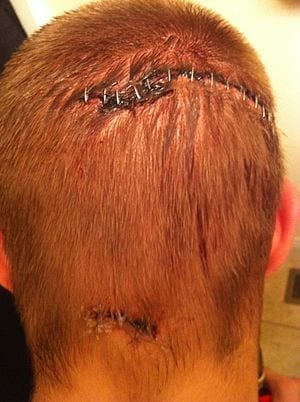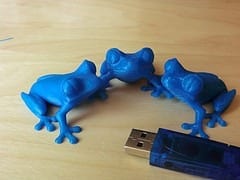
A fish parasite with a needle-like nose that pierces the intestines of its host has inspired a revolutionary medical invention that could replace surgical staples now used to hold skin grafts in place and close serious wounds.
Researchers at Brigham and Women’s Hospital in Boston, Massachusetts, led by biomedical engineer Jeffrey Karp, say they saw a need for an improved medical adhesive and looked to nature for ideas.
“When we started looking into the parasite literature, we quickly stumbled upon worms and, in particular, this spiny-headed worm that has a needle-like proboscis [nose] that inserts in the intestine of fish … and only the needles swell, so it kind of mechanically locks into place,” said Karp, describing a freshwater-fish parasite called Pomphorhynchus laevis, whose swelling and locking needle-nose design gave his team a model for the new and improved surgical bandage with unique adhesive properties.
Karp’s prototype, a microneedle-lined bandage that plumps up when exposed to water, locks painlessly into the patient’s subdermal tissue and adheres 3-and-a-half times more strongly than any clinical bandage now in use.
The elongated microneedle tips, made with a rigid plastic core, attach to stiff plastic inner and outer layers of highly absorbent material that is similar to the inside of a disposable diaper. When wet, the needles form a mechanical bond with the tissue.
The microneedle patch is also designed to eliminate two specific problems with surgery involving skin-grafts.
According to Karp, who consulted with Dr. Bo Pomahac, head of face transplant surgery at Brigham and Women’s, when conventional staples hold skin grafts in place, they can produce holes 2-to-3 times larger than the width of the staple itself, allowing for potentially harmful bacterial infections. The grafts, Karp says, are also susceptible to filling with accumulated fluids, which can prevent healing.
“Instead of using staples,” Karp said, “we would apply a microneedle patch directly on top of the skin graft that will push down to the underlying tissue and essentially lock that graft in place.”
Karp also envisions impregnating microneedle patches with antibiotics and other drugs that would infuse slowly into wounds, helping to keep them clean and quick-healing. Researchers are attempting to develop a microneedle patch that can be used to help seal, and heal, internal organs following surgery.
The Latest Bing News on:
Surgical Bandage
- Larry David Wears Bandage on His Face During Dinner Date with Wife Ashley Underwood in Los Angeleson April 27, 2024 at 10:55 am
The comedian sported a bandage taped down to his right cheek below his eye Kimberlee Speakman is a digital writer at PEOPLE. She has been working at PEOPLE since 2022. Her work has previously ...
- Wound Care Market Size is Estimated to Reach USD 30.75 billion by 2031 Owing to Rising Chronic Conditions and Surgical Procedureson April 25, 2024 at 9:38 am
Wound Care Market Size is Estimated to Reach USD 3075 billion by 2031 Owing to Rising Chronic Conditions and Surgical Procedures ...
- PowerHeal™ Revolutionizes Wound Care with Introduction of World's First and Only Bioelectric Bandage for Over-The-Counter Useon April 16, 2024 at 2:00 am
"With nearly a decade of success in the prescription surgical and wound care markets ... ranging from $5 to $14 per bandage, individuals can find the right fit for their needs, whether addressing ...
- PowerHeal™ Revolutionizes Wound Care with Introduction of World's First and Only Bioelectric Bandage for Over-The-Counter Useon April 15, 2024 at 5:00 pm
Unlike traditional wound care products, PowerHeal's one-of-a-kind bioelectric bandage represents a transformative ... burn wounds, surgical incisions, and challenging wounds such as those from ...
- PowerHeal Bioelectric Bandage Available OTC for Wound Managementon April 15, 2024 at 5:00 pm
PowerHeal ™, a bioelectric bandage cleared by the Food and Drug ... first and second degree burns, surgical incisions, donor and recipient graft sites, etc.
- Kim Kardashian Upgraded the Y2K Bandage Dress With Loads of Sexy Cutoutson April 14, 2024 at 7:50 am
If anyone can bring back the bandage dress, it's Kim Kardashian. After all, she put the style on the map back in the early 2000s with her vast collection Hervé Léger dresses that she wore ...
- Surgical management of canine aural hematomaon January 9, 2024 at 12:47 pm
The bandage and sutures should be removed after 10-14 d. Figure 3: A dog in right lateral recumbency after surgical repair of aural hematoma with postoperative bandage placement. Common ...
- What causes skin tags? How to remove them gentlyon November 27, 2023 at 12:44 am
Place a bandage over the area overnight and repeat ... However, it is important to remember that home remedies take time as compared to surgical procedures. Hence, one mustn't take a shortcut ...
- What Is a Breast Biopsy?on November 1, 2023 at 11:06 am
Once your provider finishes and removes the needle, they will apply pressure to stop the bleeding and cover it with a bandage. During a surgical biopsy, your surgical team will administer both a ...
The Latest Google Headlines on:
Surgical Bandage
[google_news title=”” keyword=”Surgical Bandage” num_posts=”10″ blurb_length=”0″ show_thumb=”left”] [/vc_column_text]The Latest Bing News on:
Medical adhesive
- Global Synthetic Polyisoprene Rubber Market Set to Reach US$ 4.6 Billion by 2032, Fueled by Demand Surge in Automotive and Medical Sectorson May 7, 2024 at 10:19 am
The synthetic polyisoprene rubber market is likely to be driven by its widespread application in the manufacturing of tires, belts, footwear, and medical accessories such as medical gloves and medical ...
- How to Transform a Medical Vial Into a Bottle Openeron May 5, 2024 at 5:00 pm
Medical-grade polypropylene has a second life in a bottle ... They are then processed with a ZE 28 BluePower twin-screw extruder and, following the mixing and blending of adhesive and liquid color ...
- A Year-Long Clinical Study Compares Self-Adhesive and Conventional Bulk-Fill Composites in Class II Cavitieson May 2, 2024 at 7:00 pm
In the study, the researchers compared the efficacy of self-adhesive and conventional bulk-fill composites in class II restorations over 12 months. They found that both materials met Federation ...
- Allergic Contact Dermatitis from Medical Adhesive Bandages in Patients Who Report Having a Reaction to Medical Bandageson May 2, 2024 at 5:00 pm
Ideally, to say that a subject does not have an ACD to a medical adhesive bandage or tape, we would want to have a negative patch-test result for both the bandage in its whole form and for each of ...
- Strong shape-memory adhesive could put Spider-Man to shameon May 2, 2024 at 2:10 am
You can stop skulking around labs trying to get bitten by radioactive spiders – a new breakthrough could make it easier than ever to get Spider-Man’s wall-crawling powers. Scientists in Singapore have ...
- Dow, Henkel and Kraton Jointly Drive Sustainability in North American Consumer Goods Industryon April 30, 2024 at 11:13 am
Henkel Adhesive Technologies, and Kraton Corporation, have achieved a reduction in product carbon footprint for two of Henkel’s North American flagship products for end-of-line packaging: TECHNOMELT® ...
- Medical Adhesive Tapes Market to hit USD 12 Bn by 2032, says Global Market Insights Inc.on April 29, 2024 at 10:00 pm
Medical Adhesive Tapes Market Size is projected to accrue USD 12 billion in revenue by 2032. The increasing demand for advanced wound care and surgical procedures is driving the industry progression.
- Silicone pressure-sensitive adhesive tapes: Engineering marvels shaping modern industryon April 29, 2024 at 3:43 am
Adhesive Applications At the core of silicone adhesive tapes lies a combination of two fundamental properties: versatility and reliability. Unlike traditional tapes, silicone pressure-sensitive tapes ...
- Scientists develop strong yet reusable adhesive from smart materialson April 28, 2024 at 5:00 pm
Scientists from Nanyang Technological University, Singapore (NTU Singapore) have developed a smart, reusable adhesive more than 10 times stronger than a gecko's feet adhesion, pointing the way for ...
- Medical Adhesive Market Poised for Substantial Growth, to Surpass USD 20.9 Billion by 2032 | Marketresearch.bizon April 9, 2024 at 5:00 pm
Marketresearch.biz reports that the Medical Adhesive Market size is expected to be worth around USD 20.9 Bn by 2032 from USD 10.5 Bn in 2022, growing at a CAGR of 7.3% during the forecast period from ...
The Latest Google Headlines on:
Medical adhesive
[google_news title=”” keyword=”medical adhesive” num_posts=”10″ blurb_length=”0″ show_thumb=”left”]










